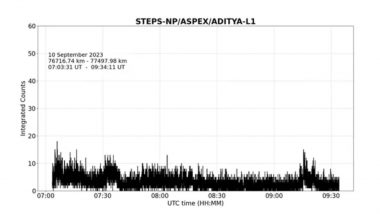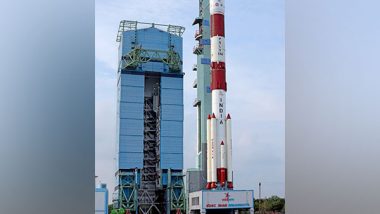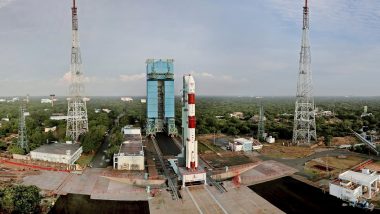Bangalore, September 18: The Indian Space Research Organisation (ISRO) announced today that its Aditya-L1 mission has commenced collecting scientific data, marking a milestone in India's solar exploration efforts. ISRO posted on X, “Aditya-L1 Mission: Aditya-L1 has commenced collecting scientific data. The sensors of the STEPS instrument have begun measuring supra-thermal and energetic ions and electrons at distances greater than 50,000 km from Earth. This data helps scientists analyze the behaviour of particles surrounding Earth. The figure displays variations in the energetic particle environment, collected by one of the units.”
The Supra Thermal and Energetic Particle Spectrometer (STEPS) instrument, a part of the Aditya Solar Wind Particle EXperiment (ASPEX) payload, has started its data-gathering operations.
STEPS, equipped with six sensors observing in various directions, is responsible for measuring supra-thermal and energetic ions ranging from 20 (kiloelectronvolt) keV/nucleon to 5 (mega electron volt) MeV/nucleon, as well as electrons exceeding 1 MeV. Aditya L1 Mission Starts Collection Scientific Data; Will Help Scientists Analyse Behaviour of Particles Surrounding Earth, Says ISRO.
These measurements are essential for understanding the behaviour of particles around Earth, particularly in the presence of the Earth's magnetic field. The activation of STEPS took place on September 10, at a distance greater than 50,000 km from Earth, equivalent to over eight times the Earth's radius. After undergoing essential instrument health checks, data collection continued until the spacecraft moved beyond the 50,000 km mark from Earth.
Each unit of STEPS is functioning within normal parameters, and the provided figure displays measurements illustrating variations in the energetic particle environment within Earth's magnetosphere, captured by one of the units.
These measurements will persist throughout the Aditya-L1 mission's cruise phase as it progresses toward the Sun-Earth L1 point, providing crucial insights into the origin, acceleration, and anisotropy of solar wind and space weather phenomena. Scientists Analyse Data From India’s Chandrayaan 1 Lunar Mission, Suggests Electrons From Earth Forming Water on Moon.
STEPS was developed by the Physical Research Laboratory (PRL) with support from the Space Application Centre (SAC) in Ahmedabad, underscoring India's growing expertise in space science and technology.
The Aditya-L1 spacecraft, India's first mission dedicated to studying the Sun, has been making significant strides. It recently completed its fourth earth-bound manoeuvre, bringing it closer to its intended mission trajectory. The spacecraft lifted off successfully on September 2, carrying seven different payloads designed for a detailed study of the Sun.
Four of these payloads will observe the Sun's light, while the other three will measure in-situ parameters related to plasma and magnetic fields. ISRO continues to expand its portfolio of space exploration missions, demonstrating its commitment to advancing scientific knowledge and space technology in India and beyond. The next manoeuvre for the Aditya-L1 mission is scheduled for September 19.
(This is an unedited and auto-generated story from Syndicated News feed, LatestLY Staff may not have modified or edited the content body)













 Quickly
Quickly





















